-
4.9 Stars ⭐⭐⭐⭐⭐ 449 Google Reviews
-
Posts
161 -
Joined
-
Last visited
-
Days Won
2 -
Carnity Points
22 [ Donate ]
Content Type
Profiles
Forums
Advice
Business Listing
Car Deals
Recall
OBD II Car Diagnostics
Guest lead capture
STORE
Events
Gallery
Blogs
Posts posted by Chirag S.
-
-
4 minutes ago, Srikumar said:
You can put a cover or atlernative if you install some wind deflectors that would help
Thanks @Srikumar for your suggestion. I appreciate, if you can refer or recommend any car accessory shop or garage who can fix it!!
-
 1
1
-
-
Hi Friends,
Two days back, i had installed roof rack on my FJ. After installation and crossing speed above 80 km, annoying aeolian noise started. This is discouraging to go for long drive and disturbance for co-passengers as well.
I need your expert advise or solution to get rid from this noise.
Thanks in advance for your time and suggestions!!
-
 1
1
-
-
On 5/14/2019 at 11:44 PM, Gaurav said:
1) Loosing the car value (depreciation)
2) Unexpected repair or maintenance
3) Falling in hand of fake mechanic
4) Making an accident (yours or other mistake)
5) All of the above
6) Any other option, please explain
Biggest headache for me , is fix cost...I.e. annual registration cost and increased insurance cost .
-
 3
3
-
-
It has glamorous features and gives complete family SUV feeling. I don't know, how good on off-road but definitely has impressive features prima facie.
I had KIA MOHAVE Top End Model before and carrying eye catcher interior features except its re-sale value. I used to take it off road as well, and was quite impressive. I hope, Telluride would have more excitement output on & off road including re-sale value!!
-
 1
1
-
-
7 hours ago, Gaurav said:
For any type of off road driving in the UAE you need to reduce your 4x4 tire pressure. For mountains and wadi it's easy to reduce between 20-25 PSI irrespective of the tire brand, shape, type and load.
For sand the tire pressure deflation is little bit tricky and if you follow below steps, you can decode this better.
Before that you also need to understand that why deflation for off road driving is so important:
- Deflated tires are hard to sink in or dig in the sand due to lesser resistance.
- Deflated tires increase the sand flotation to reduce the load on Engine, 4x4 and Transmission.
- By deflating tire pressure you increase the footprint, that help you stabilize & offer better directional control.
Image shows the two tires track: One with 35 PSI (left) and other with 12 PSI (right).
Finding a perfect tire pressure for off road driving for your specific tire and 4x4 is based on bit of learning and experiments. Of course the lower the tire pressure better it is for dune bashing, climbing and self recoveries but too low is also dangerous for popping the tire out of its wheel.
You can follow the below chart, if you are totally new to off road driving as an indication (ONLY).
- If you have a pop out on normal driving, then increase 1 PSI next time to find the best tire pressure for your 4x4.
-
If your 4x4 is Long Wheel Base (LWB) with full load then increase 1-2 PSI more than below indications.
Type/Brand of Tire
Regular Driving
Intermediate Driving
Self-Recovering
All HT Tread
(Highway Tread)Dunlop Grandtrek
Bridgestone Dueler
Yoko Geolander HT
Michelin Latitude
Pirelli Scorpion
Goodyear HT14 PSI
12 PSI
(Avoid sharp steering)
8-10 PSI
(Inflate after recovery)
All MT Tread
(Mud Terrain Tread)Mickey Thompson MT
BF Goodrich MT
Cooper STT - MT
Nitto Trail Grappler MT
Toyo Open Country MT
Dick Cepek Extreme12 PSI
10 PSI
(Avoid sharp steering)
6-8 PSI
(Inflate after recovery)
All AT Tread
(All Terrain Tread)Yoko Geolander AT
Michelin Pilot A/S3
Hankook Dynapro10-12 PSI
8-10 PSI
(Avoid sharp steering)
4-6 PSI
(Inflate after recovery)
Disclaimer: If you can't find your tire brand in the list then rely on HT / MT / AT section to be 90% safe.
For knowing how to deflate the tires, please speak to any of the Marshal or senior member to show you how its done properly. There are more than a couple of ways and tools off-roaders use to deflate depending on their choices. All tools, ways and method are correct as far as you achieve the correct tire pressure.
If you are new to offroading, I highly suggest to double check the tire pressure twice once you are done. Borrow the fellow offroader tire pressure gauge and check again, as many times your new gauge might go wonky and give false readings. Once you are 100% sure that your gauge is correct always, then you are fine to rely on your own readings.
PLEASE DON'T DEFLATE WITH KEY AND STOPWATCH AND ASSUME IT'S 14 PSI.
Secondly, always check / adjust tire pressure again after 30 minutes of sand driving as it might increase due to the heat and stress. If you are facing constant refusal at the beginning of any drive, I bet your 14 PSI has shot up to 18 PSI and you need to reduce the tire pressure more to bring it down to 14 PSI. This happens on almost every newbie drive, so it's fine and proven gazillions of time.
Very nice 👍 theory. Truly ready reckoner for all level off-roaders!! 👏🏼
-
 1
1
-
Self explanatory
-
 1
1
-
-
Very nicely eloberatd. 👏
-
 3
3
-
-
2 hours ago, Gaurav said:
I know I will have same enjoying ride at mid night too. 😀 I have tried to make correct path. Pl check.
-
 2
2
-
 2
2
-
-
1 hour ago, Gaurav said:
Thanks, Chirag, can you please share the endpoint coordinates or the track/route you have taken.
Unfortunately I didn’t save. But link of location MAP is the only details I have. After crossing wadi Sena, you will enter in wadi sidr. Place is quite and peaceful but dry. Definitely loved by Off roader and ideal for outing.
There is no indicator where to start climbing, when you’ll reach at destination as per location map. You can ask local residents or take me😀
-
 1
1
-
-
15 minutes ago, Gaurav said:
Well done Chirag for sharing this hidden gem, I have never heard about Wadi Sena before.
Few questions:
- Is road to Mountain is tarmac or unpaved?
- What is the level of driving in this wadi - can newbie drive in this area with little caution?
- Was there any water present, if you been there recently?
Thanks for your appreciation. It was nice place but unpaved road. Newbie can drive with proper caution and avoid taking risk. Personally, would not preferred to drive at night. No water, I can see in that area.
-
 2
2
-
 1
1
-
Hi,
Just wish to share my drive experience with Wadi lovers. I hope you'll share other good wadi options too.
It was good off road driving with almost one way road for mountain climbing. Good option for trekking and night camping preferably with two-three families.
https://goo.gl/maps/Pwb2SgFLtSsuvGSLA
Thanks. Have a nice weekend!!
-
 2
2
-
 1
1
-
-
3 hours ago, Gaurav said:
Traction mat - all types - are pretty much useless in the sand. They work in less than 5% perfect scenario. 95% I see them failing. I bought them too and never used it.
Tow rope work always and its best thing to have but if you are stuck in a sideways position which is very prone to flip, I will prefer winch than a tow rope, so that I can recover slowly and clear the sand pile up on the lower side of the vehicle, which causes the flip. This way after every few inches we have a chance to clear the sand wall in front of lower tires, with rope it's just one jerk and you might come out or you will flip.
With patience in hand and at a certain angle you can also use tow rope and do softer tug, maybe 4-5 soft pull and clear sand after every tug to not to build up that sand wall in lower tires.
A few weeks back we had that situation with @Shamil and @edouard asked me the same question.
A winch is also very helpful when you are stuck in some difficult spot where tow rope recovery isn't possible due to no space, like in a sand pocket or in the soft sand area, where the tugging vehicle will also get stuck due to extremely soft sand, all around. Seen this in last Bidayer drive, with Aqeel pathfinder in a soft spot and I was digging myself in with tow rope when I tried to recover him, so used the winch.
In short, you can do pretty much everything to anything without winch if you have little patience and common sense to adhere to safety issues rather than relying on ego or muscle power.
Thanks for your expert advise and sharing your experience for better clarity & understanding
1 hour ago, Barry said:Now that we’re on the topic, what’s the pros and cons of synthetic v wire ropes on winches? We have a couple of cars at work with warn winches and synthetic ropes but in the real world I only ever see wire ropes.
Thanks for sharing your views. Question is, what is best /advisable Winch option to drive in sand....
-
 1
1
-
-
52 minutes ago, Gaurav said:
A winch is the second best recovery gear after the Shovel.
It's very good to have, but it's not mandatory if you are driving with people who already have the winch. As in the whole group if you have 1 or 2 cars with winch it's very safe and optimal to venture. As in some sticky spots, a winch can save a lot of time, and in other dangerous pulls, a winch can do on slo-mo so that you can dig and clear after every few cms move to prevent the flip.
Thanks for your valuable inputs. I have one more point, in case of driving in group in sand, traction mat / kinetic rope may useful and they are cheaper than a winch cost. Then, how winch is more effective than other low cost recovery tools, in case of driving alone/ driving in group.
For your valuable guidance.
-
 1
1
-
-
I was just going through one of the website indicating difference types of Winches for 4x4. You expert advice seeking;
1. Whether winches are advisable in 4X4 including desert driving?
2. what will be the best option to go for and garage / service provider (if available)
3. It is optional and not worthful in desert drive!!
Thanks in advise in advance!! Good Day!!
_________________________________________________________________________________________________________________________________________________________
(Pl see details found on website for your ready reference)
A winch is a mechanical device made of rope, chain, or wire cable wound around a rotating spool called a winch drum. The 4WD winch is used for hauling, lifting, and adds more tension in a rope to help move the vehicle. They are powered by a motor using your vehicle’s battery or a power steering pump, which allows the winch to spin the rope in rapid motion.
A 4WD winch is technically a recovery device that will help you extract your vehicle in case you become bogged or stranded. This device is necessary especially if you plan to use your 4WD for outback travel, where muddy pits and rough roads are expected.

Important Components of Power Winches
Power winches are the most popular means of vehicle recovery. They are powered by either the engine, power steering system, or battery. Here are the most important components of power winches that allow them to function properly:
-
Motor
The motor is typically hydraulic or electric. It is the most important component of a 4WD winch that makes it function. The motor is the reason why these winches are called “power” winches. Without a motor, the winch needs to be operated manually (i.e. by hand).
-
Solenoid
A solenoid is either integrated or remote. Integrated solenoids, also known as contractors, are installed at the top of the winch. A remote solenoid is not installed on the winch. They control the direction of the winch drum rotation.
-
Wire Rope or Cable
The cable or wire rope, which is between 40 feet to 100 feet long, is neatly wound around the winch drum.

-
Winch Drum
The winch drum is where the the cable or wire rope is spooled. This spins in a circular motion to wind the rope in or out.
-
Internal Brake
The internal brake is used to keep the load stable when you stop the winch, preventing the load slipping back. This is usually located within the winch drum.
-
Gear Train
The gear train is responsible for converting the power from the winch motor into pulling power.
-
Free Spool Clutch
A free spool clutch is used to engage or disengage the winch drum from the gear train. The engaged free spool clutch position needs power to spool the cable. The disengaged position, on the other hand, allows you to wind out the cable manually at a faster speed.

3 Main Types of Power Winches
There are three main types of power 4WD winches available in the market today:
1. Power Take Off Winch
The Power Take Off (PTO) winch was the first power winch available on the market. The PTO winch is connected directly to the transfer case via a drive shaft – this drive shaft runs the gearbox of the winch. The PTO winch is powered by the engine, which means it requires the engine to be running to make it work. It is an extremely powerful winch because its power source is the engine itself. However, it is no longer very popular today.
Pros of PTO Winches:
- Very powerful winches that are really useful especially for mud bogs.
- Always have full power and you can rely on them all day long.
- They have multiple speeds available because they drive through the gearbox.
Cons of PTO Winches:
- You cannot use it if your engine is dead.
- If the winch is mounted at the front, it only pulls forward.
- More expensive compared to other types of winches.
2. Hydraulic Winch
The fully-enclosed hydraulic winch derives its power from the vehicle’s power steering system. The hydraulic motor, which is fitted to the winch, is powered by hydraulic pressure.
Pros of Hydraulic Winches:
- Very powerful as the power supply is also derived from the engine through the power steering pump.
- Secondary battery is not needed.
- Motor cannot be affected by water immersion.
Cons of Hydraulic Winches:
- Cannot run without engine.
- Available in two speeds.
- Only pulls forward if the winch is front-mounted.
- If the steering is altered during winching, the winch stops running.
3. Electric Winch
Th 12V-powered electric winch is the most widely used 4WD winch today. The electric winch derives its power from the vehicle’s battery first and then from the alternator. This type of winch doesn’t need the engine to work for a short period of time. However, it’s best to bring an extra battery during a long trip as the battery is the source of its power.
Pros of Electric Winches:
- Lightweight and easy to use.
- Widely available in the 4WD market.
- Can be used even if the engine is dead, as long as the vehicle’s battery is powered.
Cons of Electric Winches:
- May not be very powerful and efficient.
- Uses a lot of energy from the battery so a secondary battery is recommended.
- Single speed of operation only.
- The electric motor can be affected when immersed in water.
- Only pulls forward when mounted in the front.
The Manual Winch: Hand Winch
The hand winch is a manual type of winch which doesn’t need an engine or a battery to run. It derives its power from the driver or anyone who will operate the winch. All it needs for the hand winch to work is time and energy from the operator.
Pros of Hand Winches:
- It doesn’t need engine or battery to operate.
- It can be used to pull the vehicle forward, from the rear, or from either left or right side of the vehicle.
Cons of Hand Winches:
- It takes time to operate.
- It is manual so it needs a lot of effort from the person operating it

4WD Winches: Which is the Best Option?
The “best” 4WD winch really depends on the situation you are in. Power take off and hydraulic winchesare great if your situation requires a lot of power. However, for situations when the engine can run, the electric winches are the most suitable to use. It’s important to remember that electric winches only work with dry cell batteries.
All three types of power winches only pull forward when front-mounted. They are great for towing or pulling another vehicle. However, if the vehicle with a winch is stuck and it cannot be recovered through a forward pull, then the hand winch would be most helpful. Hand winches are a great option if you need to pull from the rear, left, or right.
-
 1
1
-
-
On 4/9/2019 at 9:45 AM, Emmanuel said:
Shuweihat Island, Location, Waypoints, Photos, Videos, Reviews and Feedback from the travellers who visited before.
Shuwaihat Island offers the best mix of clear water shallow beaches with beautifully textured rocks and zero light pollution to enjoy the stars like never before. This island is a perfect place for any photographer to capture incredible shots of great variety from the sky, water, rocks, sun, beach, sea in one place. Sandstone colour rocks and low-lying cliffs that look like mini caves are mesmerizing in itself.
Shuweihat Island is about 3 hours and 30 minutes away from Dubai and 2 hours and 30 minutes from Abu Dhabi. As you will be driving on International Highway E11 so be confident to overtake truckers every now and then at high speed.
Although you can reach in a sedan car, but getting closer to the water or reaching to tall rocks or crossing the rocky terrain 4WD is better. I visited Shuwaihat Island on the last national day weekend and this place was very crowded with hundreds of cars. Shuweihat Island scenery is so beautiful that you can spend hours doing nothing and enjoying the nature if you plan to visit during good weather. You can enjoy the rocky formation and clear water shoreline is amazing, of course with sandals as the beach is mixed with sand and rocks.
If you plan to stay here for long, you should carry enough water and food as there is no grocery or cafeteria nearby. You can fill up the petrol in the last Adnoc Fuel station at Qareen Al Aish and pack up the food supplies as this Adnoc gas station is big enough to have a convinient store, ATM, restaurant and toilets.
Adnoc at Qareen Al Aish: https://goo.gl/maps/PSQ2hvJWHJy
This is my recommended spot that I found the best in terms of scenic beauty and access to the beach.
https://goo.gl/maps/B3utEm8nYmv
24°06’42.2”N 52°25’57.4”E
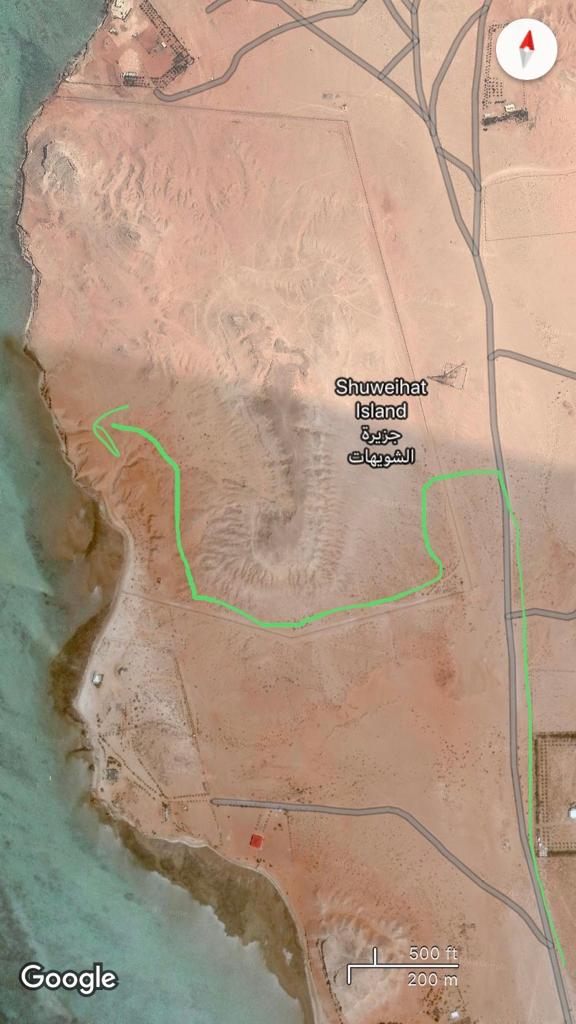
Reviews:
- Tripadvisor - 4 out 5 based on 10 reviews
- Google: 4.6 out of 5 based on 152 reviews
Best time to visit: October to May, when the weather is not too hot for outdoor.
Shuweihat Island Entry Fee: There are no charges to visit or using public areas
Shuweihat Island Timing: It is open 24/7, 365 days, you can enjoy in day and night too.
Shuweihat Island Camping: Not sure if it's allowed everywhere, as part of Shuweihat Island is owned by Army. If you happen to make an attempt, keep it clean and less noisy and you might get away.
Essentials: Outdoor clothing and closed footwear, few good torches or flashlight if you plan to stay after dark. Online GPS is a must for driving (offline is even better), carry plenty of water and food if you plan to stay outdoors for long hours.
Keep it clean: Don't litter anywhere, because trash cans, plastic and glass kill wildlife.
Emergency: If bitten by a snake or a Scorpio take a picture or remember the colour and size and rush to the nearest hospital for a specific antidote for that species. Keep yourself calm, so your blood pressure and heartbeat stay low to help you minimize the effect.
Feedback: Please leave your feedback below if you have been to Shuweihat and like to add something more.
Great effort!!
-
 2
2
-
Congratulations
-
 3
3
-
-
Welcome @Pradeep TP.
-
 2
2
-
-
13 minutes ago, Srikumar said:
If you are offroading with us you will never need offroad assistance. Your car will be recovered till the road
I have full faith on that!!
13 minutes ago, Gaurav said:Yes it is available from IMC and AAA paid service, I think they are in the range of 1500 - 2000 dhs and they aren't covered in your offroad insurance cover, as it reads - roadside assistance.
Other than paid, there are few SOS Instagram group as well, and also 999 can help in terms of some serious life and death matter.
Thanks for Sharing such valuable information.
-
 3
3
-
 1
1
-
-
Hi,
For sake of information and curiosity, I wish to get your expert opinion / guidance on off road side assistance service. As we know, for driving on road, road side assistance service is available. But for off road drive, off road assistance is available too? I don't know. Seeking your guidance / expert advise!!
Thanks.
-
 2
2
-
 1
1
-
-
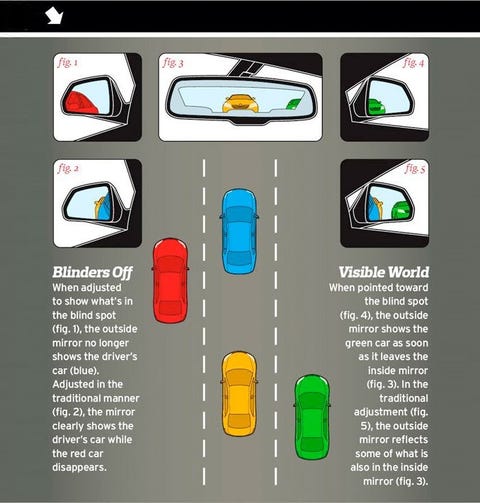
@Gaurav @Asif Hussain Pl see one of the screenshot I found. May be useful to others too.
-
 4
4
-
-
2 minutes ago, Gaurav said:
Reversing in the dunes, I trust my own judgement than anything shown on the mirror, screen or sensors.
Best is to roll down the window to have a good shoulder view on either side and keep reverse with partial eyes on rearview mirrors or screen. Secondly while reversing in dunes, I pay attention to the car level more, that means if im dipping on left I counter steer on right to stay on flat rather than dropping in some unseen sand pocket or dune.
In the night drive in the desert, it's a whole different game. Don't reverse as far as possible, if you have to step out and see first and then decide how many exact meters of the reverse is needed.
Thanks for your valuable advise.....
-
 4
4
-
-
3 minutes ago, Asif Hussain said:
Watch this Vedio. I am sure you will not stick anything on your mirror.
I am thankful for your feedback...
4 minutes ago, Asif Hussain said:Watch this Vedio. I am sure you will not stick anything on your mirror.
Also, while taking reverse, behind the car view is not clear & reverse camera is not effective so. especially while taking reverse on dune, due to its typical design, it is not friendly or confident view. Do you have any good suggestion / expert opinion on this too..
-
 2
2
-
-
Are stick-on convex mirrors worthful for FJ to get rid from blindspot problem. Pl give your expert opinion...
-
 2
2
-
-
2 minutes ago, Brette said:
@Chirag S. nothing will happen if they open the bonnet and spray the engine bay. Years ago some cars used to have a problem starting if water was sprayed in the engine bay with high pressure as water used to get into places it should not but with current cars it is not a problem.
I pressure wash the engine bay on my Grand Cherokee every alternate week and have been doing this to my cars for the last 10 years at least. If you do have access to an air blower, use that to blow out the excess water after the wash or ask the service center to do it if you are getting the car washed out.
Besides it being a good habit to keep the engine bay clean, it also helps you detect any new leaks that need your attention.
Good to know. Thanks for your guidance
-
 2
2
-


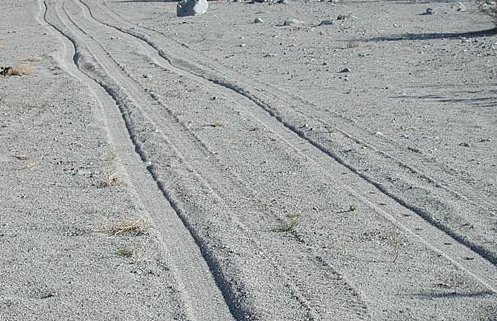

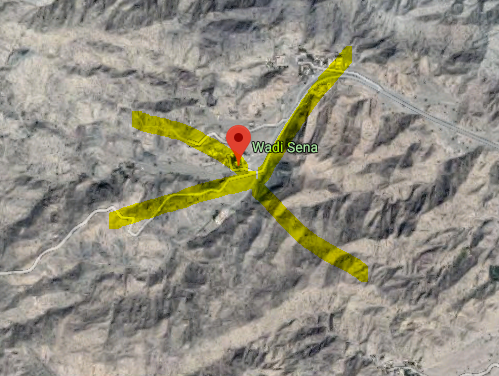
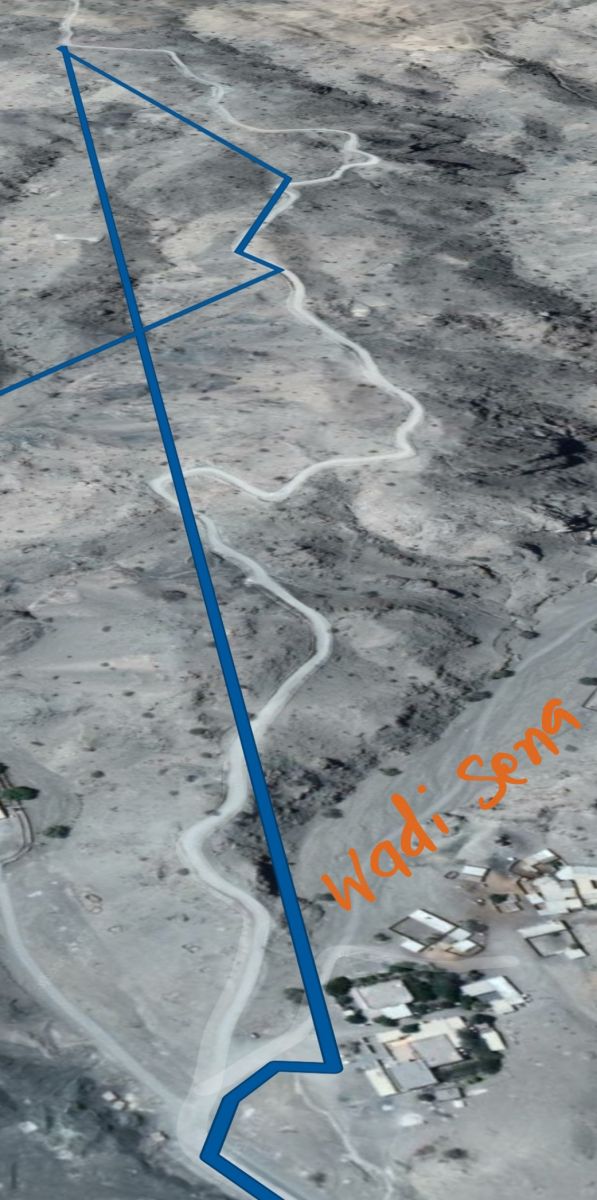
![Wadi_Sena[1].jpg](https://carnity.com/uploads/monthly_2019_06/Wadi_Sena%5B1%5D.jpg.4df8663b0a5a43228c33d8ae03216466.jpg)
![Wadi_Sena_2[1].jpg](https://carnity.com/uploads/monthly_2019_06/Wadi_Sena_2[1].jpg.c0340de328041fcb0c9deb27cdbf7fb0.jpg)
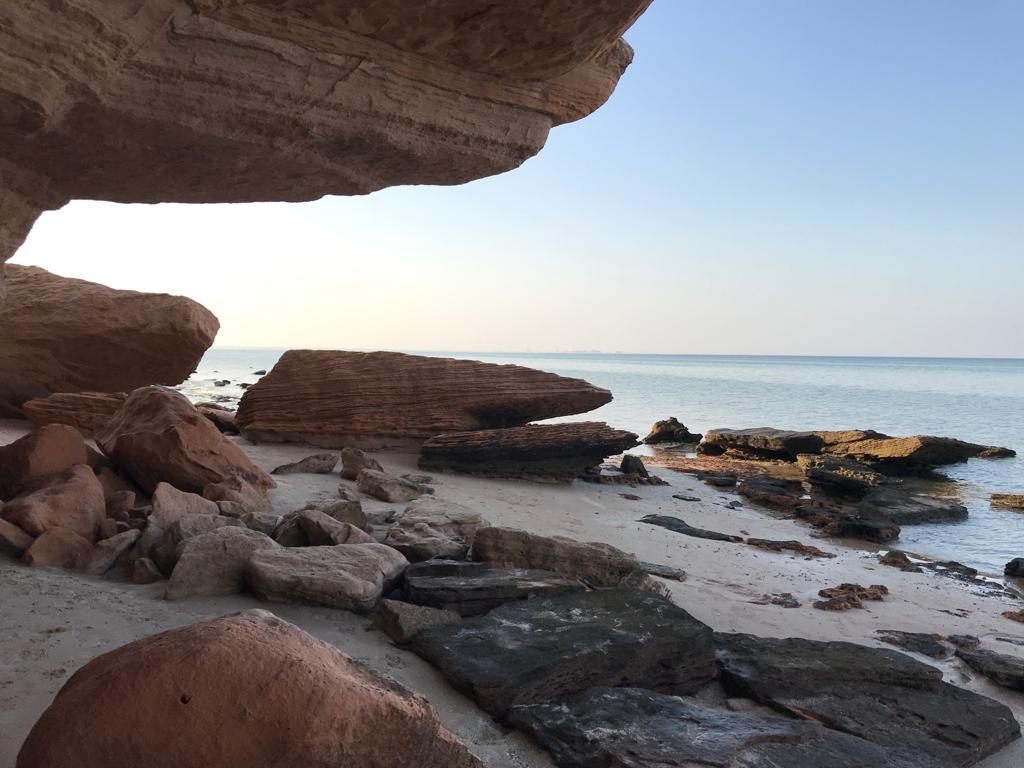
.jpeg.d67e25a2d23641ace75513999c557f66.jpeg)
.jpeg.4032897f150e468773f1b2b4cc42180d.jpeg)
How do I stop my roof rack from whistling?
in General Discussions
Posted
thanks @Javier M for your kind suggestion